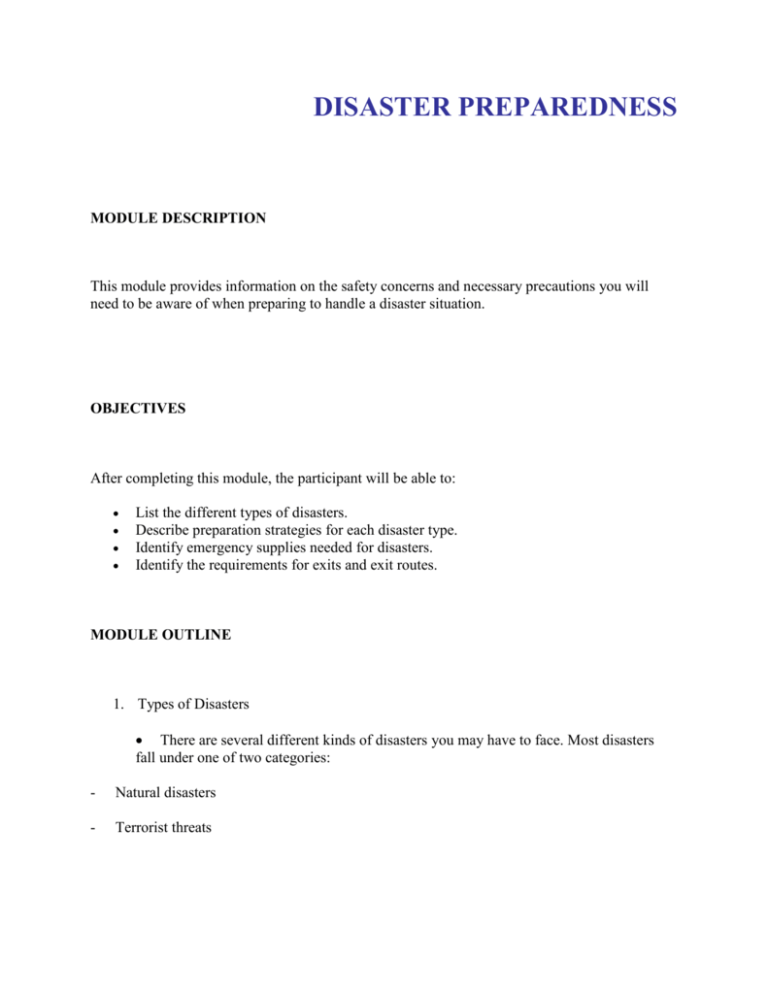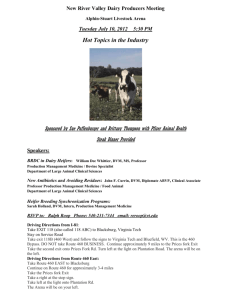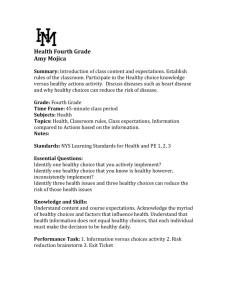Disaster Preparedness Fact Sheet
advertisement

DISASTER PREPAREDNESS MODULE DESCRIPTION This module provides information on the safety concerns and necessary precautions you will need to be aware of when preparing to handle a disaster situation. OBJECTIVES After completing this module, the participant will be able to: List the different types of disasters. Describe preparation strategies for each disaster type. Identify emergency supplies needed for disasters. Identify the requirements for exits and exit routes. MODULE OUTLINE 1. Types of Disasters There are several different kinds of disasters you may have to face. Most disasters fall under one of two categories: - Natural disasters - Terrorist threats Natural disasters include fires, earthquakes, floods, tornados, and hurricanes, while terrorist threats include biological attacks, chemical attacks, nuclear explosions, and radiation threats (dirty bombs). 2. Preparing for Natural Disasters Employers are responsible for researching the natural disasters that are most prevalent in their area of work and planning accordingly. Your workplace should have an established emergency escape plan, and all employees should be aware of their specific roles if that plan has to be put into effect. This includes understanding any specific medical or supervisory responsibilities. The use of floor plans or workplace maps, which clearly show the emergency escape routes, should be included in the emergency action plan. It is also important to handle and store flammable and combustible materials according to OSHA standards so they do not pose a hazard in the event of a natural disaster. The standards for handling and storing flammable and combustible materials are covered in more detail in the Materials Handling, and Flammable and Combustible Materials modules. 3. Terrorist Threats In any terrorist threat, it is important to be prepared to react to the disaster, to stay calm, and to respond according to the situation. However, there are specific ways to prepare for particular kinds of terrorist threats. Key Terms: - Biological Attack: A biological attack is the deliberate release of germs or other biological substances into the air or water. Many agents must be inhaled, enter through a cut in the skin, or be eaten to be effective. Unlike an explosion, a biological attack may or may not be immediately obvious. It is possible that you will physically see signs of a biological attack, as was sometimes the case with the anthrax mailings. But, it is more likely that local health care workers will report a pattern of unusual illness, or there will be a wave of people seeking emergency medical attention for similar symptoms. o In the event that you become aware of a biological attack in your area, you should get away as quickly as possible, cover your mouth and nose with layers of fabric that can filter the air but still allow breathing. - Chemical Attack: A chemical attack is the deliberate release of a toxic gas, liquid, or solid that can poison people and the environment. Watch for signs of a chemical attack, such as people suffering from watery eyes, twitching, choking, having trouble breathing, or losing coordination. If you see signs of a chemical attack, quickly try to define the impacted area or where the chemical is coming from. If the chemical is inside the building where you are, try to get out of the building without passing through the contaminated area by following an established escape route. If you cannot safely exit the building or area, move as far away as possible from where you suspect the chemical was released and seal the room. o If your eyes are watering, your skin is stinging, you are having trouble breathing, or you simply think you may have been exposed to a chemical, immediately strip and wash. Look for a hose, fountain, or any source of water. Wash with soap, if possible, but do not scrub the chemical into your skin. Seek emergency medical attention. - Nuclear Explosion: A nuclear blast is a type of explosion with intense light and heat, a damaging pressure wave, and widespread radioactive material that can contaminate the air, water, and ground surfaces for miles around the explosion site. While experts currently believe that a nuclear attack is less likely than other terror attacks, terrorism, by its nature, is unpredictable. o If there is a flash or fireball, take cover below ground immediately. If this is not possible, any shield or shelter will help protect you from the immediate effects of the blast and the pressure wave. In order to limit the amount of radiation you are exposed to, think about shielding, distance, and time. If you have a thick shield between yourself and the radioactive materials, it will absorb more of the radiation, and you will be exposed to less. The greater the distance you are from the blast and the fallout, the lower your exposure. Finally, minimizing time of time you are exposed also reduces your risk. - Radiation Threat: A radiation threat or “dirty bomb” is the use of common explosives to spread radioactive materials over a targeted area. This is not the same as a nuclear blast, as the force of a “dirty bomb” explosion and its radioactive contamination will be more localized. o While the blast will be immediately obvious, the presence of radiation may not be clearly defined until trained personnel with specialized equipment are on the scene. As with any radiation, you want to try to limit your exposure. Again, think about shielding, distance, and time. 4. Emergency Supplies In order to be ready to respond to a disaster, it is very important to keep a kit of emergency supplies in the workplace. If you live in a cold weather climate, you must think about warmth. It is possible that the power will be out, and you will not have heat. Your workplace should consider keeping cold weather supplies on site in case of disasters, including: jackets or coats, hats, gloves, sleeping bags, and/or blankets. Other emergency supplies to keep in your workplace include: - One gallon of water per person per day, for drinking and sanitation - At least a three-day supply of non-perishable food - A battery-powered radio and extra batteries - A flashlight and extra batteries - A first Aid kit - A whistle to signal for help - A dust mask or cotton T-shirt, to help filter the air - A wrench or pliers to turn off utilities - A c an opener for food (if kit contains canned food) - Plastic sheeting and duct tape to shelter-in-place - Garbage bags and plastic ties for personal sanitation 5. Preparing for Disasters You, as well as your employer, should plan in advance what you will do in an emergency. You should: - Be prepared to assess the situation—use common sense and whatever you have on hand to take care of yourself and others around you. - Ask your employer about your workplace emergency plans. - Find out how your employer will communicate with employees during an emergency. - If your employer does not have an emergency plan, consider helping develop one. Depending on your circumstances and the nature of the attack, the first important decision to make is whether you stay put or get away. You should understand and plan for both possibilities. Use common sense and available information, including what you are learning here, to determine if there is immediate danger. In any emergency, local authorities may or may not immediately be able to provide information on what is happening and what you should do. However, you should watch TV, listen to the radio, or check the Internet often for information or official instructions, as it becomes available. If you are specifically told to evacuate or seek medical treatment, do so immediately. Key Terms: - Staying Put: There may be situations when it’s simply best to stay where you are and avoid any uncertainty outside. Plan in advance where you will take shelter in this kind of an emergency. Choose an interior room, or one with as few windows and doors as possible. Use available information to assess the situation. In fact, there are some circumstances where staying put and creating a barrier between yourself and potentially contaminated air outside is a matter of survival. If you see large amounts of debris in the air, or if local authorities say the air is badly contaminated, you may want to shelter-in-place and seal the room. Take your emergency supplies and go into the room you have designated. Seal all windows, doors, and vents with plastic sheeting and duct tape, or anything else you have on hand. Listen to the TV, the radio, or check the Internet for instructions. - Getting Out: There may be conditions under which you will decide to get away, or you may be ordered to leave. Your employer is responsible for making sure your workplace has a building evacuation plan that is regularly practiced. They should also take a critical look at your heating, ventilation, and air-conditioning systems to determine if they are secure or if they could be feasibly upgraded to better filter potential contaminants. Be sure you and others know how to turn off these systems if necessary. Also, think about what to do if you can’t go home, and make sure you have appropriate supplies on hand. If you choose to get out of the building, it is very important to be aware of exit and exit route locations. Exit routes are the main component of an evacuation plan and are defined as a continuous and unobstructed path of exit travel from any point within a workplace to a place of safety (including refuge areas). - It consists of three parts: 1. The exit access; 2. The exit; 3. The exit discharge An exit route also includes all vertical and horizontal areas along the route. Key Terms: - Exit Access: The portion of an exit route that leads to an exit. An example of an exit access is a corridor on the fifth floor of an office building that leads to a two-hour fire resistance-rated enclosed stairway. - Exit: Exits are defined as the portion of an exit route that is generally separated from other areas to provide a protected way of travel to the exit discharge. An example of an exit is a twohour fire resistance-rated enclosed stairway that leads from the fifth floor of an office building to the outside of the building. - Exit Discharge: The part of the exit route that leads directly outside or to a street, walkway, refuge area, public way, or open space with access to the outside. An example of an exit discharge is a door at the bottom of a two-hour fire resistance-rated enclosed stairway that discharges to a place of safety outside the building. OSHA has laid out design, operation, and maintenance standards for exits and exit routes. Exit Standards - Exits must be permanent. - An exit should have limited openings. - Exits must be separated from the rest of the structure by fire resistant materials. - Exits must lead outside. - An exit door must be unlocked and should not be accessed through a room that can be locked. - A side-hinged exit door must be used. - Exits must meet minimum height and width requirements. Exit Routes - The number of exit routes must be adequate. - Exit route access must be unobstructed and free of material and equipment. - The capacity of an exit route must be adequate. - An outdoor exit route is permitted. The number of routes is dependent on the amount of employees. Generally, two exit routes, remote from each other, must be available to employees. A single exit route is permitted where the number of employees, the size of the building, its occupancy, or the arrangement of the workplace indicates that a single exit will allow all employees to exit safely. Other means of escape, such as fire exits or accessible windows, should be available where fewer than two exit routes are provided. More than two exit routes must be available when the number of employees, the size of the building, its occupancy, or the arrangement of the workplace reasonably suggests the need for more than two routes. Additionally, exits must lead directly outside to a street, walkway, refuge area, or to an open space with access to the outside. All of these areas must be large enough to accommodate all building occupants likely to use the exit. A refuge area must be along an exit route and be protected from the effects of a fire. Or it must be a floor with at least two spaces separated by smoke-resistant partitions in a building where each floor is protected by an automatic sprinkler system. The requirements for operation and maintenance of exits and exit routes are as follows: - The danger to employees must be minimized - Lighting must be adequate - Exits must be properly marked - The fire retardant properties of paints or other coatings must be maintained - Each emergency safeguard must be maintained - Exits must be maintained during construction and repair - An employee alarm system must be operable To minimize danger to employees, exit routes must be free of explosives or highly flammable furnishings or decorations. Additionally, exit routes must not require employees to travel toward materials which burn very quickly, emit poisonous fumes, or are explosive, unless those materials are effectively shielded from the exit route. Also, exit signs must be appropriately marked. To do this, the sign must be clearly and visibly marked, illuminated to a surface value of at least 5 foot candles by a reliable light source, and painted in a designated exit sign color. The exit door itself must be free of signs or decorations that obscure its visibility, and any doorway or passage that may be mistaken for an exit must be marked “Not an Exit.” Signs must be posted along the exit route indicating the direction of travel to the nearest exit, and the line-of-sight to an exit sign must be uninterrupted. 6. Preparing for Natural Disasters Some of the things you can do to prepare for the unexpected, such as making an emergency supply kit and developing a workplace communications plan, are the same for both a natural or man-made emergency. However, there are important differences among natural disasters that impact the decisions you make and the actions you take. Planning what to do in advance is an important part of being prepared. Since all employers are responsible for finding out what natural disasters are most common in your area, you can ask them which ones affect your area the most. You may be aware of some of your community’s risks; others may surprise you. For example, historically, flooding is the nation's single most common natural disaster. Flooding can happen in every U.S. state and territory. Earthquakes are often thought of as a West Coast phenomenon, yet 45 states and territories in the U.S. are at moderate to high risk from earthquakes and are located in every region of the country. While some disasters can occur anywhere, others may be more common in certain areas. Tornados are nature’s most violent storms and can happen anywhere. However, states located in “Tornado Alley,” as well as areas in Pennsylvania, New York, Connecticut, and Florida are at the highest risk for tornado damage. Hurricanes form in the southern Atlantic Ocean, Caribbean Sea, Gulf of Mexico, and in the eastern Pacific Ocean, so if your workplace is located in a coastal community, you should be prepared to respond to a hurricane.






